I taught knitting for several years.
And one phrase that used to make me cringe every time I heard it was, “do I really have to do a gauge swatch?” The reason it made me cringe is that NOTHING is more linked to the success of your final product than gauge. Nothing. Not fiber. Not color. Not price. And not even pattern. You could get free cashmere, pick the most beautiful pattern in the whole world, perfectly suited to your shape and in a beautiful color, and if your gauge is off, the project will look bad, and not fit.
Do a gauge swatch. Every time, do a swatch.
“But I am not good at math.” or “I don’t understand why/how to do one.”
Math is for everyone when it is related to a sweater. When people explain fractions using pieces of pie, everyone can relate. So when knitters talk about math to estimate if a new sweater will fit, then math is for everyone. Stop a minute. Sketch it out. And run the numbers. It will make sense if you see it.
The main issue with gauge is that a little problem gets multiplied into a BIG problem across the span of a project. Let’s talk about the measurements for one fictional sweater as an example. The sweater is supposed to be 38 inches around the bottom cast on, and you are supposed to get 4 stitches per inch, and you are supposed to cast on 152 stitches.
If you are knitting tighter, and you are getting 4.5 per inch, you will loose 4.25 inches! (Your sweater would now be 33.77 inches around.) On the other end of the spectrum, if you knit 3.5 st/inch instead, your sweater would be a gracious 43.42 inches around, and just HANG off you.
Either way, you have completely missed the mark you were going for.
Gauge is defined on the yarn label using a 4 inch square. (This is so that the metric world can talk to the imperial world without a conversion chart. 4 inches is almost exactly 10 cm.)
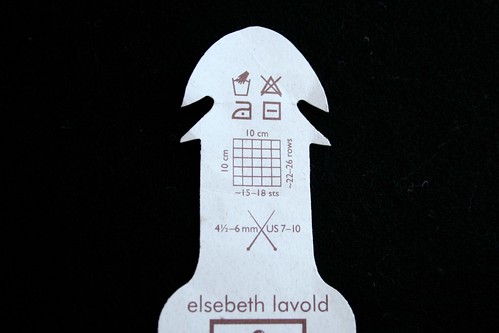
Here, the label on my yarn says that I ‘should’ get 15 – 18 stitches over 4 inches.
They suggest I use between a 7 – 10 needle.
That is a pretty big variance, so there needs to be some testing to figure out where my knitting falls in that range. Test your gauge by using several different needles in the range that they suggest.
To make sure that you are not optimistically stretching or squishing your square, cast on 2-4 stitches more than they suggest, so that the 4 inch square will not include edge stitches or the ‘curling under’ part.
Knit about 3-4 inches up (in stockinette stitch) and then switch to another needle and do another swatch. I like to leave the swatch(s) connected, and put in a row of purl (on the right side) as a line of demarcation where I change needles. Then I don’t have to guess later.
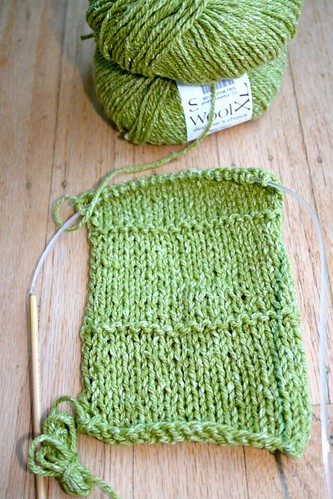
For my swatch I started on 8’s, then went to 7’s and finally to 6’s.
Stockinette stitch will curl naturally. So your swatch will be curled on the ends.
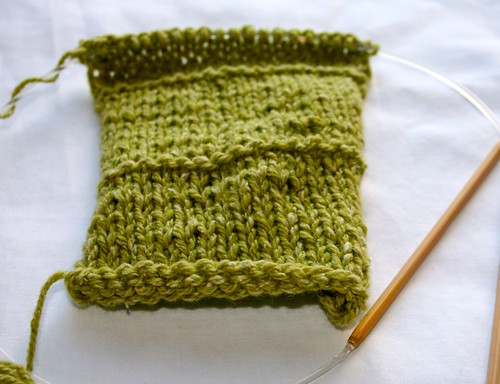
You will want to measure it uncurled.
If you are new to knitting, or you have trouble you could pin it down, as shown here.
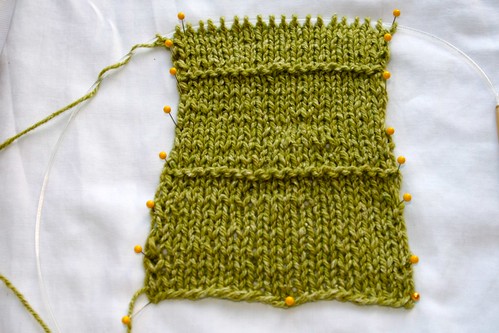
It is not pulled or stretched at all. Just uncurled, and pinned down.
To count the stitches, you can use the “knit check” and put the ‘window’ over your stitches.
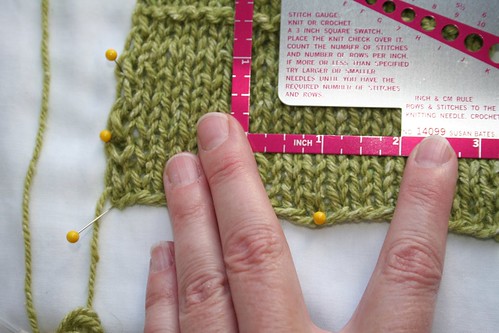
Keep in mind that the window is 2 inches, so you will have to double your number.
If you are using a regular ruler, or you want the consistency of measuring across 4 inches, then you can employ this trick. Put in one bobby pin, measure 4 inches, and slip in another bobby pin. then count the stitches between the pins.
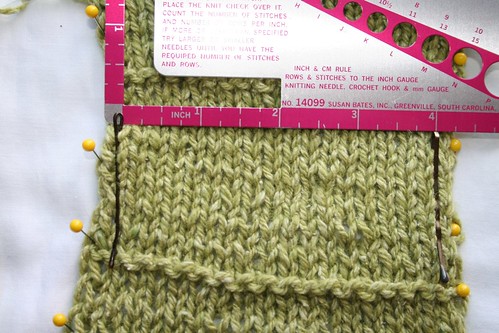
Once you have done your swatch, have a look at the stitches objectively, and decide if you like the ‘tension’ in the fabric itself. (this part is personal preference.) Can you see air through the stitches? Do you prefer to do a more “open” stitch? Or, is it tighter? And do you prefer to see the tighter stitches?
Once you decide which one you would like the best, then check your pattern, and see if you can make that work. Normally, if you have bought yarn for a specific project, there will be a size that will fit with the gauge you like.
(We will talk about how to change a pattern, and work outside the gauge they have specified in another post.)
I hope this information is helpful.
Please write if you have any specific questions that we could help answer.
© 2005 – 2011 Kathy Lewinski & Susan Cornish

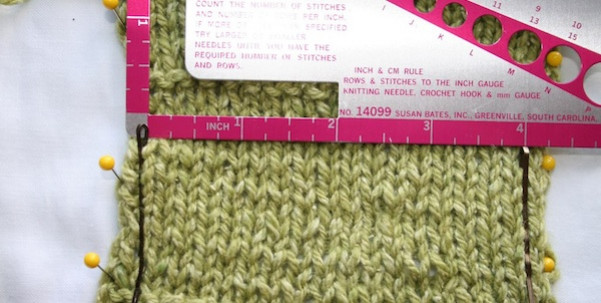


I have tried to learn yarn arts for years and I see to have an inability to remember which way I went and which way I need to go. I think I am borderline dyslectic. Do you have any ideas to help a person with this learning style?
Thanks!
I admit that the reason why I haven’t started the 8000 ft hoodie is because of the gauge swatch. I have the yarn and the needles, but just haven’t started. I realize it is very important but the motivation hasn’t been there. Your post just might the thing I need to get it going this weekend. Thanks Susi!
Manisha, Just do a swatch, and we will do the math together. I am almost ready to start. (I have one more project to move off the needles first.)
I did a swatch. Finally! I was supposed to have 23, but I was bit closer to 22 1/2. Honestly? I thought ‘close enough’ and started knitting, but with the intention to knit tighter. I had made a point of knitting really loose while knitting the swatch. I’m not that far along, so I could start over if I need to. What do you think? This is why I’m so freaky about swatches. I have limited supplies so I don’t want to have to go out and get another set of needles. Arghhh!
Manisha, You are close, but for you to really love the garment, let’s get closer. What size were you planning on making, and then we’ll do the math.
Hi Susi,
I went to Kat’s house last night for knitting and there, I redid my swatch which she said was “spot on”. Woo-hoo!!!! I realized that I may have been measuring it wrong all along. Thanks for offering to help!
Manisha – You couldn’t have been more spot on with your gauge after you did it “normally.” Your sweater is going to just speed along now. Can’t wait to see the colorwork in your gorgeous color choices.
So so jealous! knitting at Kat’s house!!!
I’m glad you got it all figured out! I can’t wait to watch your sweater grow!
So, simple, and so necessary. Thanks for the simplicity of this check. The only thing that swatching is, is time consuming. You get that patterrn that your eye says is something you can’t live without making and you have to get started so you can see the finished product. Well, the time you have to “tink’ because it doesn’t fit is a lot more than the time it takes to swatch. It is a word that makes you shever, but a good way to start all porjects. Thanks again for the lesson.
Charlotte, Thank you. A lot of people dont even bother to tink (or Frog) at that point. It is too heart breaking. They just finish the sweater and give it to a loved one who will fit the project. And that is crushing in a different way.
Gauge while watching TV.
It’s the only way. Then you are not “wasting time”.
Susi
A wise knitter taught me to do the same type gauge swatch you do, with successive needle sizes. But, and this has helped more than once, she advised at the beginning of each new needle section, to on the first row do a K1, YO, K2tog and repeat, with the number of YOs equaling the number (size) of the needle used in that section. If you like and use that same yarn in the future, you already have a headstart on gauge!
Thank you for this! I’m a tight knitter and I’m making a sweater for myself, for the first time.
I make a couple of swatches, with different needle sizes, but I wish I had read this ahead of time — I like the tip of casting on extra rows and keeping the swatches connected with a purl row.
This was a super helpful explanation of how/why to do gauge swatches…. I always do them for wearables, but rarely for the toys or unpatterned objects I think of as doodles… this post of yours helped me visualize clearly how swatches help gauge what you need to do to get your desired result, something I have a great deal of trouble putting in words.
I think I’ll keep knitting square swatches though, if outsized from the ones on the package–I like the bunny pattern for knit squares, and plan on using old swatches for it 🙂